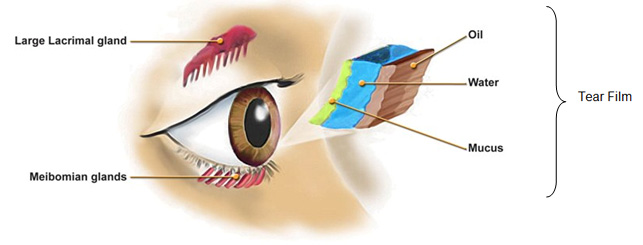One of the most common complaints I hear in my office is, “My eyes feel dry.” Many people get that scratchy, irritated feeling to their eyes and know what the problem is. Even more people, however, come in complaining of a whole host of eye symptoms, not knowing that many of them are caused by dry eyes. These include blurred vision that improves with blinking, “tired eyes” or “eye strain”, eye pain, light sensitivity and frequent tearing (a reflex due to dry eye sensation). Yes, even eyes that feel wet a lot can be dry. Let’s first talk about why we tear, then why our eyes are dry, and lastly, what we can do about it.
First, it is important to know that our tears are crucial for good vision. The first thing light hits when it reaches your eye is the tear film on the surface of your cornea. The cornea is like the front window to the eye and the tears are like a polish on that window. With each blink, the eyelid spread a smooth layer of tears across the cornea. This light is then focused by the cornea and lens onto the retina, forming an image. When the tears dry out on the cornea, they leave a bumpy, irregular surface that distorts the light coming into the eye and makes the image blurry. If the tears are continually drying out between blinks, the surface of the cornea becomes constantly irregular due to dead and dying corneal surface cells. This often triggers a reflex to produce lots of tears, so many that our tear drain system is overwhelmed and the tears drain down our face. When we see this in the clinic, we diagnose dry eyes.
Our tears are made up of 3 components: oil, water and mucus. The watery part is made mainly in the lacrimal gland which is in the upper outer part of our eye socket under the upper eyelid. There are also many smaller glands on the insides of our eyelids. The skin on the inside of our eyelids makes mucus and rows of glands on our eyelid margins, just behind the eyelashes, make the oil. All three of these components have to be present in the right amounts to make tears work. Without water, the tears gum up and you get eye matter. Without oil, the tears dry out very rapidly between blinks. Without mucus, the tears are too thin and don’t cover the eye well.
This brings us to the causes of dry eyes:
- Lack of tear production. This happens due to age, inflammation of the tear glands (such as in Sjögren syndrome), hormonal changes causing less production and loss of reflex tearing.
- Excessive tear evaporation. Excessive evaporation can occur due to tears having not enough oil (usually due to blockage of the oil ducts) and not blinking enough (common when using the computer or reading).
- Eyelid problems that prevent the tears from being where they need to be. Eyelid problems also lead to dry eye. These include poor blink due to a facial nerve problem (i.e. Bell’s palsy, facial or head injury), eyelid deformities, eyes not closing after over-aggressive eyelid lifting, and in cases where the eyes protrude, such as thyroid eye disease.
So what can be done about it?
- Get properly diagnosed by an ophthalmologist who knows dry eyes. They will do this by looking at your eyes with a microscope, analyzing your tears with special drops and other tests, and looking at the health of your corneal surface. They will also examine the eyelids to ensure you blink and close the eye appropriately.
- Use artificial tears. Nearly all types of dry eyes benefit from extra tears. They need to be used often, at least 4 times daily and up to every 10-30 minutes in severe cases. There are many different viscosities of tears. The thicker they are, the longer they’ll last, but thicker tears tend to blur the vision for a while after they are given. Tear ointments are also helpful, especially at night as they can significantly blur the vision when used during the day.
- Keep your natural tears around longer. Plugs that block off the tear drains in your eyelids will keep you from swallowing away all those tears as they drain into your nose. In more severe cases, we often permanently close off the tear drains, which can greatly improve the eye surface. Your natural tears can be enhanced by taking omega-3 supplements.
- Practice good eyelid hygiene. Warm compresses on the eyelids to helps oils to flow out more easily into the tears. Lid scrubs with mild baby shampoo and warm water along the eyelash margin will also keep the oil flowing and keep matter from accumulating in the eyelashes.
- Prevent excess evaporation. Blocking out moving air can reduce evaporative tear loss. This is done by wearing close fitting sunglasses during the day and even special moisture goggles to bed at night. Avoid sleeping under a ceiling fan or blowing the air conditioning at your eyes while driving.
- Reduce or eliminate contact lens wear. Contact lens wearers can use tears or “re-wetting solution” to keep the eyes more moist and improve lens wear comfort. Never wear them overnight and clean them often, no matter what the lens manufacturers say.
- In special cases, treat inflammation. In a small number of people with inflammation of the tear producing glands, eye drops like Restasis can help produce more tears. In my view, this medicine is over-prescribed in this country and few patients truly get a benefit from it, so caveat emptor.
Dry eye is common and annoying, but can be readily treated and may improve your vision and overall eye comfort. If you have questions or would like a consultation, call our office at 801-264-4420 or email me at [email protected].

